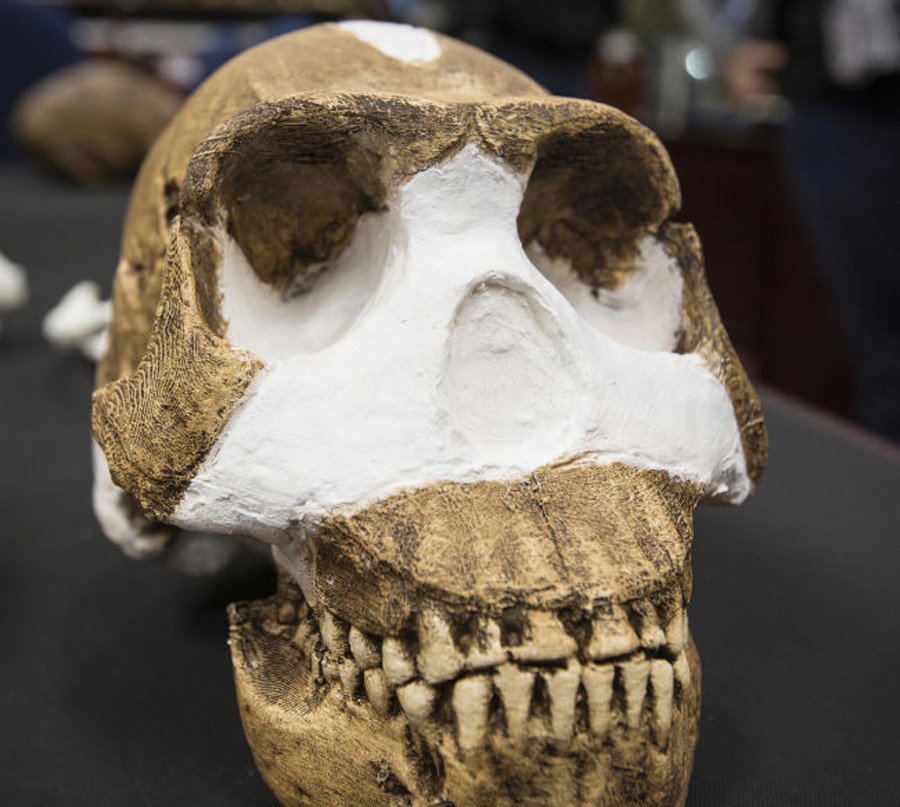'Tiny brain, slender body': New human-like species discovered in S. African cave

Scientists in South Africa have unearthed a new species of human relative in a burial chamber deep down in a remote cave system, naming it Homo naledi. It’s the single largest fossil hominin find yet made on the continent.
It's believed the discovery, consisting of over 1,550 numbered fossil elements representing at least 15 individuals, may “alter views of human behavior.” Paleontologists have come to the conclusion that H. naledi deliberately deposited bodies of their dead in a remote cave chamber – behavior previously thought limited exclusively to humans.
According to scientists, H. naledi had a tiny brain, about the size of an average orange (about 500 cubic cm), perched atop of a “very slender body.”

The research, published in the journal Elife, shows that on average H. naledi stood approximately 150cm tall and weighed about 45kg. Its teeth are described as similar to those of the earliest-known members of our genus, such as Homo hanilis, as are most features of the skull. The shoulders, however, are more similar to those of apes.
Their hands meanwhile suggest “tool-using capabilities,” according to Dr. Tracy Kivell of the University of Kent, UK.
“Surprisingly, H. Naledi has extremely curved fingers, more curved than almost any other species of early hominin, which clearly demonstrates climbing capabilities,” she said.

The feet of H. naledi appear to be “virtually indistinguishable from those of modern humans,” Dr. William Harcourt-Smith of Lehman College, City University of New York, who led the study of H. naledi's feet. Its feet and long legs suggest that the species was well-suited for long-distance walking.
READ MORE: Fossils from 460 million year old human-sized sea scorpion unearthed in Iowa
“The combination of anatomical features in H. naledi distinguishes it from any previously known species,” Lee Berger, research professor in the Evolutionary Studies Institute at Wits University, stated in a press release.
The initial discovery was made by Wits University scientists in 2013 in the Rising Star cave system located in the Cradle of Humankind World Heritage Site, only 50km from Johannesburg. The fossils, which have yet to be dated, were discovered in a chamber about 90 meters from the cave entrance, accessible only through a chute which proved to be so narrow that a special team of super-slender volunteers was needed to retrieve them. So far, the team has recovered parts of at least 15 individuals of the same species. Scientists say it's just a fraction of the fossils believed to remain in the chamber.

H. naledi was actually named after the Rising Star cave. 'Naledi' means 'star' in Sesotho, a South African language.
“With almost every bone in the body represented multiple times, H. naledi is already practically the best-known fossil member of our lineage,” Berger said.
“Overall, H. naledi looks more like one of the most primitive members of our genus, but it also has some surprisingly human-like features, enough to warrant placing it in the genus Homo,” a senior author of the paper describing the new species, John Hawks of the University of Wisconsin, US, said.

It's not the first time that the study of our relatives has provided evidence that humans are not unique in regards to certain kinds of behavior.
In 1960, the world's foremost expert on chimpanzees, English primatologist Jane Goodall, traveled to what was then the Gombe Stream Chimpanzee Reserve in the British protectorate of Tanganyika to study the behavior of the wild chimpanzees.
Goodall watched from a distance as a chimpanzee, which she named David Greybeard, poked pieces of grass into a termite mound and raised the grass to his mouth. When he left, the primatologist repeated the behavior since she was not sure what David was doing. Much to her surprise, she discovered that the termites bit onto the grass with their jaws, and the chimpanzee had been using the grass as a tool to ‘fish’ for termites.














